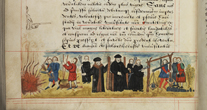Resident in the town of Cambridge
 |
| Plague bill reporting the number of deaths in Cambridge by parish, 1666 (UA T.X.21.28) |
From the start, the university had to negotiate its existence with the town. The university was consumer and the town supplier of all the necessaries of academic life, from food and lodging to gowns and books. Periodic friction saw its most violent eruption during the Peasants’ Revolt in 1381, when university property was burned outside Great St Mary’s church. The Crown, habitual patron and protector of the university, handed it sweeping powers thereafter to ensure its material safety and more. Until the mid-nineteenth century, oversight of trading standards at markets and fairs, maintenance of roads, water supply, public health and policing were in its hands, enforced by the proctors and taxors. A system of university courts handled offences affecting both university members and ‘privileged persons’, as townspeople in their employ were known, and provided testamentary services.
Victorian reforms righted the balance between the two corporations of university and town, though control of student morals and pockets was retained. Well into the twentieth century, the university licensed wine sales and theatre productions and censured improvident tradespeople.
Click to view larger images:
